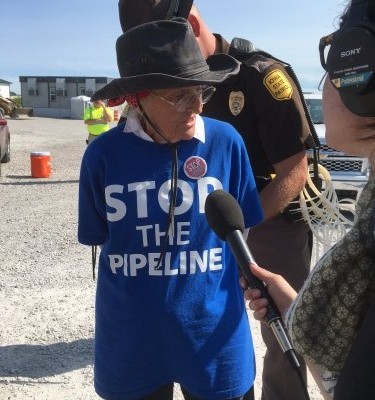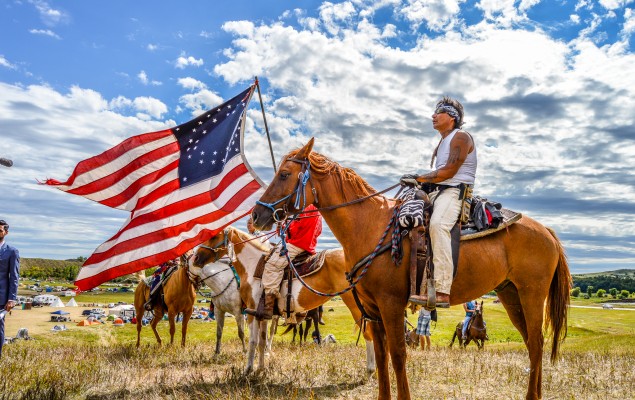Across the country allies are pulling together, just like we did on Keystone XL, to help stop the risky and unnecessary Dakota Access pipeline.
Below is an update that groups such as IEN, 350, CREDO Action, Honor the Earth, Sierra Club, Oil Change and Bold pulled together to help make sure advocates and press understand the process and current updates.
You can help support our work on stopping the Dakota Access pipeline: DONATE HERE
Mekasi Camp, our Bold Oklahoma Coordinator and member of the Ponca Nation, is living in North Dakota at the Standing Rock camp. He is one of the lead logistical coordinators and can always use more hands! Follow Bold Oklahoma on Facebook for updates.
Ed Fallon, our Bold Iowa Director, is leading actions on the ground with landowners, farmers and working with partners like Iowa CCI and the Bakken Resistance Coalition. Over 50 people have been arrested in Iowa and Dakota Access is now suing us trying to restrict our freedom of speech and right to assemble. Follow the actions on Bold Iowa’s Facebook page.
Bold is researching ideas on winter lodging both for North Dakota but also Iowa as Native and non-Native folks hunker down for a long winter. We are looking at various “tiny house” plans, solar barns and more. So if you have ideas, please send me an email jane@boldnebraska.org.
All resources we raise support actions on the ground from legal fees for folks who engage in civil disobedience, supplies needed at the camp and creative actions we are leading and partnering with in both Iowa and North Dakota.


Update and Background from Allies on the Dakota Access Pipeline
In recent weeks, opposition to the controversial Dakota Access pipeline has grown exponentially, drawing the attention of the national mediaand activists across the country.
The Dakota Access pipeline, which would extend 1,168 miles – just seven fewer than the now rejected Keystone XL pipeline – across North Dakota, South Dakota, Iowa, and Illinois, would threaten communities, farms, Tribal land, sensitive natural areas, and wildlife habitat. It would pass within just half a mile of the Standing Rock Sioux reservation, putting sacred sites, burials, and culturally important landscapes at risk and posing a devastating public health threat to the Tribe’s drinking water in the case of a spill. It would also cross directly through lands in North Dakota reserved for the Standing Rock Sioux Tribe, the Yankton Sioux Tribe, the Cheyenne River Sioux Tribe, and others by the 1851 Fort Laramie Treaty, as well as the Yankton Sioux Tribe’s aboriginal title lands in South Dakota.
In addition to its potential impacts on land and water, new analysis shows that building the pipeline would also be inconsistent with the United States’ climate goals. According to a new analysis by Oil Change International (OCI), the pipeline would lock in greenhouse gas emissions in an amount equivalent to the emissions of 30 coal plants. By reducing shipping costs for large amounts of dirty oil, particularly with current oil prices so low, building this pipeline would significantly increase the amount of crude oil getting to market. OCI calculated that, at typical utilization rates of 95% of capacity, total lifecycle emissions from producing, transporting, processing, and burning the products derived from the oil would amount to 101.4 million metric tons of CO2e per year. Given this estimated impact and the White House’s recent guidance on how federal agencies should assess climate impact, it is only logical that a climate test be applied to this project, but thus far none has been conducted by the Administration.
Tribal and farming communities have been engaged in resisting Dakota Access for years, and as legal proceedings continue, resistance has continued to grow, both on the ground and across the country.


Since April 1, members of the Standing Rock Sioux Tribe and other Indigenous Nations have occupied a spirit camp, the Camp of the Sacred Stones, located between the pipeline’s proposed crossing of the Missouri River and the water intake valves for the Tribe. The camp is a center of spiritual and cultural opposition to the pipeline, with the goal of stopping construction through prayer and nonviolent direct action. Action at the camp intensified in August when construction was set to begin along the Missouri River crossing. Members of the Standing Rock Sioux Tribe have been joined by thousands of Native and non-Native people from across the continent, including representatives from over 250 tribes and First Nations. New camps have been placed on both sides of the Cannonball River, which forms the northern border of the Standing Rock Sioux Tribe and flows into the Missouri River, with participants risking arrest. So far, 68 people have been arrested as part of the protests in North Dakota, including the Tribe’s chair, Dave Archambault Jr. Contrary to inaccurate claims by local police and media, the camp has been entirely peaceful and nonviolent.
In Iowa, landowners and farmers are resisting handing over their land to Dakota Access with a lawsuit defending their property rights from eminent domain abuse. Environmental and Native allies are working shoulder to shoulder with landowners engaging in civil disobedience and formal proceedings at the Iowa Utilities Board. Over 51 people have been arrested, and over 2,000 have signed a pledge of resistance to get arrested, for peacefully protesting. Planned actions over the next several months include a massive rally in Des Moines on Oct. 30, 2016. Additionally, Dakota Access is suing Bold Iowa and Iowa CCI to prevent both nonprofits from exercising their right to assemble and freedom of speech.
As local communities continue to stand against the pipeline in North Dakota and Iowa, opposition has reached all the way to Washington, D.C. On August 24th, hundreds of activists, joined by high-profile allies like Shailene Woodley, Josh Fox and Susan Sarandon, rallied outside the U.S. District Court in support of the Standing Rock Sioux Tribe. On Tuesday, September 13th, more than nearly ten thousand people joined over 100 solidarity rallies across the country to call on President Obama to halt construction of the full Dakota Access pipeline and conduct a full environmental analysis including tribal consultation. The rallies were organized by indigenous groups such as Honor the Earth and the Indigenous Environmental Network as well as the Sierra Club, CREDO Action, 350.org, Bold Alliance and dozens of other organizations.
Tribal and local governments from across the government have also stood with protesters. An unprecedented 188 tribal resolutions have been issued in support of Standing Rock, as well as city council resolutions from Seattle, WA; St. Paul, MN; Minneapolis, MN; Portland, OR; Bellingham, WA; St. Louis, MO; and Lawrence, KS.
The Tribe has also gained the support of Members of Congress, including Sen. Bernie Sanders and Rep. Raul Grijalva, as well as 31 leading national and local environmental, tribal, and landowners’ rights organizations, who recently sent a letter to President Obama urging him to direct the Army Corps of Engineers to repeal the pipeline’s permits.


What’s next for the Dakota Access pipeline
On July 27th, the Standing Rock Tribe filed a lawsuit and a request for a preliminary injunction to block construction of the pipeline. The complaint, filed in federal court in Washington D.C. by Earthjustice, argued that the Army Corps of Engineers violated the National Historic Preservation Act by failing to address the Tribe’s concerns about the pipeline’s impact to sacred sites and culturally important landscapes, and that the river-crossing permits must be subject to review under the National Environmental Policy Act. Standing Rock has since been joined in its suit against the Corps by the Cheyenne River Sioux Tribe, and the Yankton Sioux Tribe has also filed a complaint against the Corps and the U.S. Fish and Wildlife Service. Both the Yankton and Cheyenne River Sioux Tribes are being represented by Fredericks Peebles & Morgan LLP.
Since filing the lawsuit, Standing Rock submitted detailed findings of its archeologist to the court, which described human burial sites, stone prayer rings, and other sacred artifacts directly in the path of the proposed pipeline. As LaDonna Brave Bull Allard of the Camp of Sacred Stones noted in a recent Yes Magazine article, “Of the 380 archeological sites that face desecration along the entire pipeline route, from North Dakota to Illinois, 26 of them are right here at the confluence of these two rivers. It is a historic trading ground, a place held sacred not only by the Sioux Nations, but also the Arikara, the Mandan, and the Northern Cheyenne.” It is clear that construction should not be allowed to proceed without further consultation with the tribes and analysis of environmental and cultural or historical impacts along the route are conducted, but the day after the discovery of these sacred sites, the pipeline company intentionally bulldozed the sites before they could be inspected, as well as ramping up their violent confrontations of peaceful protesters.
On Friday, September 9th, the Washington, DC District Court denied Standing Rock’s motion for preliminary injunction, meaning that the court allowed construction to proceed while the Tribe’s lawsuit goes forward. This decision is currently being appealed.
Shortly thereafter, the Departments of Justice, Army, and the Interior announced that the agencies would not issue the remaining permits for the pipeline to cross Corps land bordering or under Lake Oahe until it determines whether further environmental review is warranted. The Army Corps has not yet sent over the land easements to Congress which has authority to review the federal land crossings. This is a necessary step in the permitting process.
We applaud the Obama administration for taking action, but this temporary halt to construction does not resolve the issue. We call on the administration to suspend pipeline construction in all areas of federal jurisdiction until the agencies can determine the scope of further consultation and review under the National Environmental Policy Act (NEPA) for the entire proposed route.
Let’s keep working to stop this pipeline. Big Oil wants us to believe because some of the pipe is in the ground this is a lost cause. Reality is, even the Big Oil lobbying group understands the power of the people when they said, “if you get a permit, that no longer protects you if your neighbor decides they want to object.” Exactly right, especially with an export pipeline project that does not even have all of the required permits to operate or build in our country.
You can help support our work on stopping the Dakota Access pipeline: DONATE HERE



